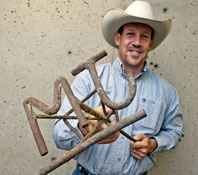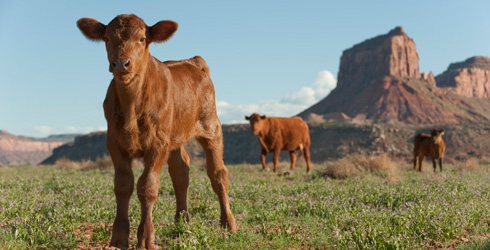“Brand awareness” and “brand infringement” are marketing phrases that have a slightly different twist in the West. Brand awareness refers to the 15,000 different brands and earmarks identifying livestock on Utah’s ranches and open range.Brand infringement is also called cattle rustling.
Utah has 62 full-time brand inspectors, a profession most career counselors overlook when talking to high school seniors. Last year, these men and women oversaw 700,000 cattle being sold or transferred in Utah. Cody James heads the brand inspection bureau for the Utah State Department of Agriculture.
“Utah brand laws date back to 1886,” Cody says. “A cattle brand has a language all its own that you read like a book.” A rancher pays $75 to have his brand pictograph registered with the state. Every cow on the open range must be branded in one of six locations on its body. This bovine VIN marker tracks ownership and guards against rustlers.
“They’re out there,” Cody says. “This crime didn’t die off in the 1800s. A cow can be sold for about a thousand dollars and can be hauled off at night in a truck or horse trailer. Some rustlers have trained dogs to herd cattle to a pickup site. Unbranded calves, called “slicks,” are the toughest. There is no way to prove ownership, and they can be rustled in the trunk of a car.”
To protect ranchers, the state has a livestock theft investigator who spends his days literally riding the range. “It’s the perfect John Wayne-type job in the twenty-first century,” Cody says. Some aspects of the job have changed over the years. No longer are rustlers hung from a cottonwood tree. Now they face a third-degree felony charge with up to five years in prison.
James grew up on a ranch in Tooele County and loves his work. “You spend your days amongst honest, hardworking people. What’s better to do than talking about cows?”
The same aggie background helped Suzanne Butler become an inspector for Salt Lake and northern Utah Counties. No cattle are being herded down the I-15 corridor these days. But even with this areas dense development, in May alone she oversaw the transfer of 2,000 local cows. Ranchers (several near the airport) call Suzanne when they are ready to move their herds. Sometimes she inspects cows from 5 am to 7 pm, and she can recognize up to 25 brands from memory.
For any little girl who aspires to her career, Suzanne suggests getting involved with the 4-H and FFA programs. “Stay connected with the land,” she says. §







